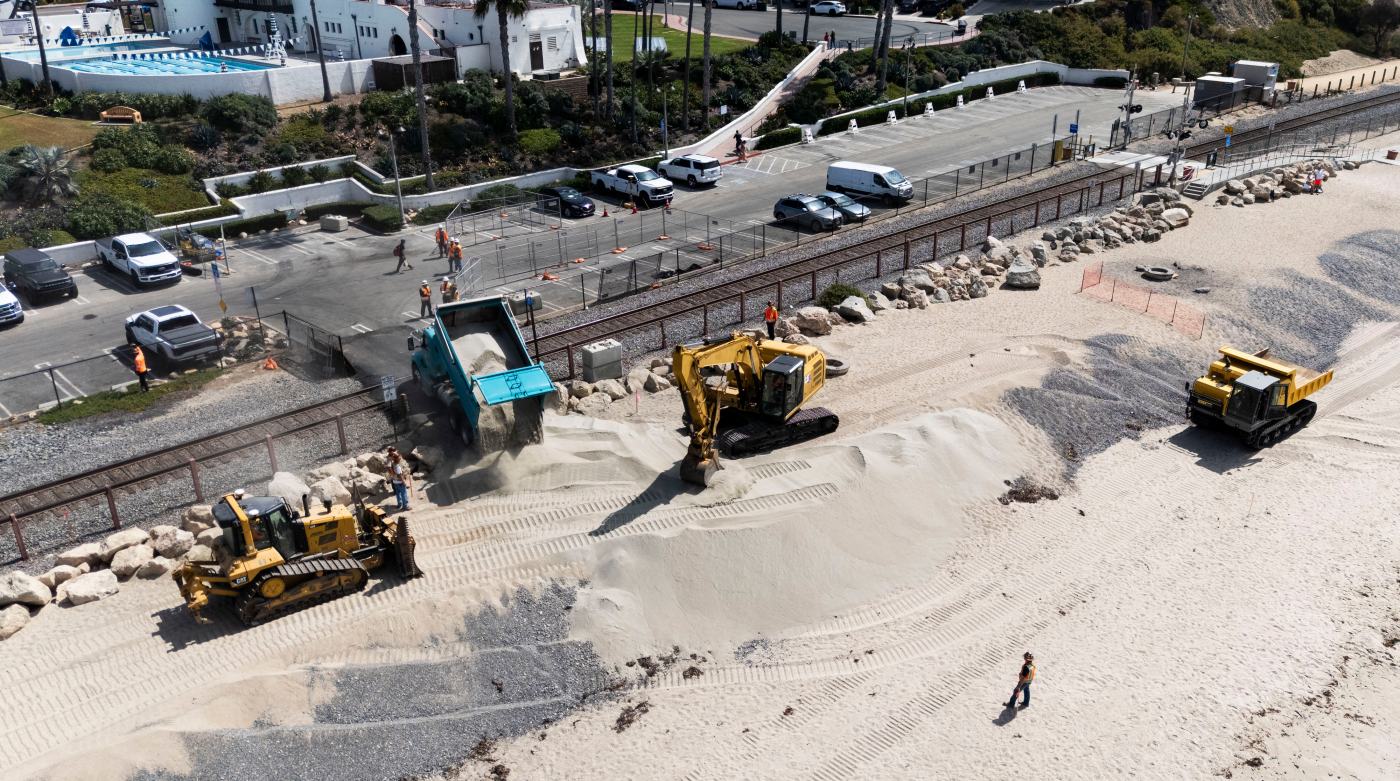Sand is being shipped from a quarry in Palm Springs to San Clemente’s North Beach, a test case to see how the desert grains hold up at the shore.
The Orange County Transportation Authority’s initial deposit will be 3,400 cubic yards of sand hauled to North Beach as part of efforts to protect the coastal rail line that has been damaged in recent years by landslides and ocean erosion — a small amount compared to the 250,000 cubic yards it hopes to place down on the north stretch of the beach town in the long run.
For now, because of U.S. Army Corps of Engineers restrictions on placing sand below the mean high tide line, that’s all that can be brought in, said Fifth District Supervisor and OCTA board member Katrina Foley.
“It’s making it difficult for us to solve the problem of expanding the beaches, because of that rule,” she said.
The estimated $900,000 replenishment project kicked off Friday, Sept. 5, and will continue over the next week with about 300 trucks unloading the sand onto the beach.
OCTA gained approval earlier this year to use a mix of sand and rock boulders to protect its rail line on the north end of town, which has suffered several shutdowns of service in recent years.
The plan is to deposit about 540,000 cubic yards of sand on the north and south ends of town, along with rock boulders, between the tracks and the ocean, and build catchment walls on the inland side near Mariposa Beach.
About 250,000 cubic yards of sand and 7,400 tons of boulders for the north end of the beach town have earned approval, while plans for 2,100 tons of boulders, an “engineered revetment” with 33,000 tons of material, and about 300,000 cubic yards of sand are still pending environmental review.
Finding the easiest and most cost-efficient way to bring in sand is no easy task. An Army Corps of Engineers project that delivered sand from Surfside in Huntington Beach cost millions of dollars more than expected due to the distance.
Also, waiting for available dredgers to pull sand from ocean sources could delay placement for years.
The city is exploring closer offshore sand sources, and also recently tested gray sand from British Columbia to see how the grains meshed near the lifeguard headquarters.
Foley said the most feasible solution may be making use of sand built up in the Prado Dam, which needs to be dredged by the Army Corps of Engineers. About a year ago, North Beach was seeded with about 37,000 cubic yards of sand from the Santa Ana River, with truckloads hauling the material in and spreading it out.
The idea is to dredge out 100,000 cubic yards of sand and place it on county land nearby, where it can be cleaned, sorted and picked up by trucks to haul to San Clemente.
If the initial project is successful, another 150,000 cubic yards can be scooped out, fulfilling a chunk of OCTA’s obligations for sand nourishment.
That project, however, is still in the permitting process. Dredging of the site is only allowed in October and November and the county has yet to receive approvals from the Army Corps of Engineers to use an easement road to remove the sand.
“If we don’t get it approved, literally within weeks, we miss the window,” Foley said.
The idea is to have it set up to be done annually, she added.
“We need to approach the coastline like we do road repair,” she said. “We have to maintain the beaches, replenish the sand. And we have to develop an ongoing maintenance plan.”
Since 2021, emergency response to landslides and erosion damage to this coastal section of the 351-mile Los Angeles-San Diego-San Luis Obispo, or LOSSAN, Corridor has cost taxpayers more than $40 million to restore service.
The OCTA’s full project price tag is about $310 million, the funding already secured from state and federal sources.
Study is also underway by the OCTA on a longer-term look at addressing rail needs in the next 30 years, while the state is leading exploration of future solutions that could include relocating the rail line.
Work will also begin later this month by OCTA to build a new 1,400-foot-long reinforcement wall on the inland side of the Mariposa Bridge, allowing for a beach path to be built to reconnect the city’s popular coastal bike and pedestrian path that was damaged along with the train tracks.
There will be no beach closures, OCTA officials said, though workers may direct beachgoers via flags around some areas.












